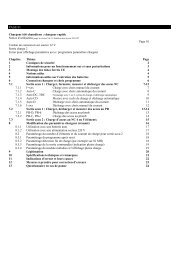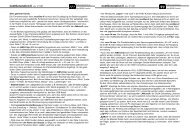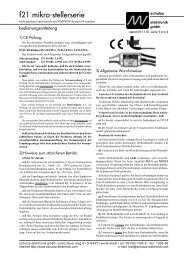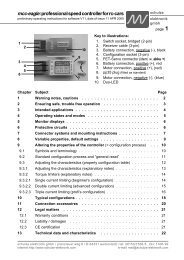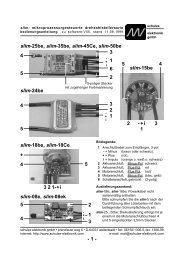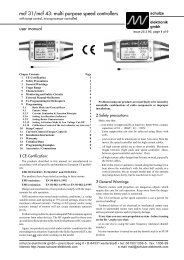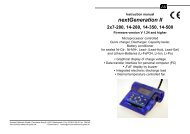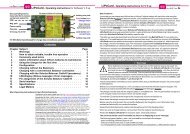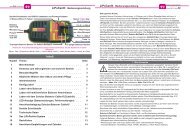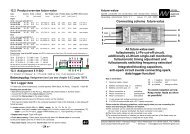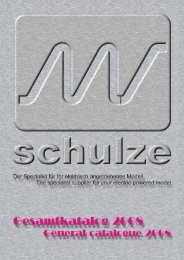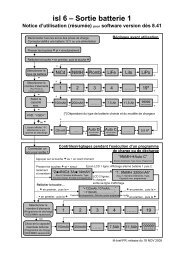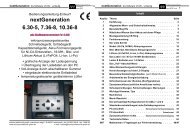ecolader: rapid discharger/charger series - Schulze Elektronik GmbH
ecolader: rapid discharger/charger series - Schulze Elektronik GmbH
ecolader: rapid discharger/charger series - Schulze Elektronik GmbH
Create successful ePaper yourself
Turn your PDF publications into a flip-book with our unique Google optimized e-Paper software.
Page 20 <strong>ecolader</strong>: <strong>rapid</strong> <strong>dis<strong>charger</strong></strong>/<strong>charger</strong> <strong>series</strong><br />
8.15.4 Fix -D<br />
Purpose:<br />
Program designed to discharge a pack<br />
quickly to the pre-set final discharge voltage.<br />
Description:<br />
The <strong>ecolader</strong> checks whether the set maximum<br />
discharge current will exceed the permissible<br />
discharge power limit.<br />
If so, it reduces the discharge current to a<br />
permissible value, and superimposes a<br />
flashing asterisk on the LCD screen.<br />
If not, the <strong>ecolader</strong> discharges the pack using<br />
your chosen current.<br />
The program discharges down to the final<br />
discharge voltage at a constant current.<br />
After this the discharge process is halted.<br />
Notes:<br />
Please bear in mind that high discharge currents<br />
(around 2 C or higher) will cause the<br />
battery to heat up. Cool it if necessary.<br />
You can allow the <strong>ecolader</strong> to calculate the<br />
final discharge voltage automatically, or set<br />
a limit value instead (see Section 8.17).<br />
At high discharge currents, and - in particular<br />
- when packs are being discharged<br />
simultaneously at akku 1 and akku 2 outputs,<br />
the <strong>charger</strong> can get very hot. To avoid<br />
over- heating, the discharge current is reduced<br />
in two stages, at which time the "reduced"<br />
symbol ("*") appears on the screen.<br />
Even when cooled down the full current will<br />
not flow until at least one pack is completely<br />
discharged.<br />
8.15.5 Auto-D<br />
Purpose:<br />
Optimum program for <strong>rapid</strong>ly but gently discharging<br />
batteries completely down to the<br />
final discharge limit. Ideal for erasing the<br />
memory effect of Ni-Cd batteries, and/or<br />
preparatory to completely discharging them<br />
using individual resistances.<br />
Description:<br />
The <strong>ecolader</strong> checks whether the set maximum<br />
discharge current will exceed the permissible<br />
discharge power limit.<br />
If so, it reduces the discharge current to a<br />
permissible value, and superimposes a<br />
flashing asterisk ("*") on the LCD screen.<br />
If not, the <strong>ecolader</strong> discharges the pack using<br />
your chosen current.<br />
The program discharges down to the final<br />
discharge voltage at a constant current.<br />
After this the discharge current is reduced<br />
gradually so that the the voltage does not<br />
fall below the set final discharge voltage limit.<br />
When the discharge current falls to a fraction<br />
of the pre-set value, the discharge process<br />
is halted.<br />
Notes:<br />
Please bear in mind that high discharge currents<br />
(around 2 C or higher) will cause the<br />
battery to heat up. Cool it if necessary.<br />
You can allow the <strong>ecolader</strong> to calculate the<br />
final discharge voltage automatically, or set<br />
a limit value instead (see Section 8.17).<br />
At high discharge currents, and - in particular -<br />
when packs are being discharged simultaneously<br />
at akku 1 and akku 2 outputs, the<br />
<strong>charger</strong> can get very hot. To avoid overheating,<br />
the discharge current is reduced in<br />
two stages, at which time the "reduced"<br />
symbol ("*") appears on the screen. Even<br />
when cooled down the full current will not<br />
flow until at least one pack is completely discharged.<br />
schulze elektronik gmbh • prenzlauer weg 6 • D-64331 weiterstadt • tel: 06150/1306-5, fax: 1306-99<br />
internet: http://www.schulze-elektronik.com e-mail: mail@schulze-elektronik.com



